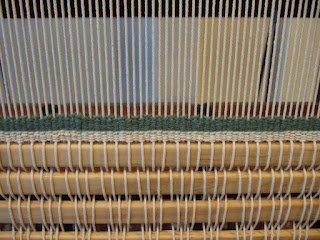
I began weaving the next tapestry a couple of days ago. Here's how I'm working. I have the painting from which I'm adapting as I weave hanging on top of the loom. I tried it in two other places (behind the loom and hanging at the side) and really couldn't easily see it for reference. I thought it might not interfere with the shed changing if I draped it over the top beam and it works just fine there, at least for the lower part of the image. Since it's painted on canvas I believe I can roll it up to expose more of the design as I need to see it.


I began by tying on to the lower rod, weaving in several thin wood molding strips, then a few passes of the cotton seine twine I'm using as warp, the 12/18 Finnish cotton from Shannock. Next there was a single twining row of the same seine twine followed by several passes of scrap 2 ply wool. This will be unraveled as I finish the ends. I've been attempting to resolve how I want the edges to be finished for years and have used many methods. This time I'll either thread alternate warp ends into the channel of the adjacent one, then cut off the one that remains hanging close at the edge (I learned this from Marti Fleischer a few years ago), or I'll use a half-Damascus edging as described in Peter Collingwood's classic book The Techniques of Rug Weaving, page 485 and 486. Here's a link to a pdf of the pages in Collingwood's book that describe the Damascus and half-Damascus edge--takes a bit of time to download if you're on dial-up. The pdf is from the Ralph Griswold online digital archive of textile publications--link here.

Because the edge of the warp shows a bit I wanted to make it less jarring to the bright colors of the tapestry by weaving a narrow and irregular border in light color weft around all four sides. I'm using single weft interlock rather than sewing slits for most of the vertical join areas. Since Archie Brennan showed me how to do this interlock in the smoothest way I've used it quite a lot on tapestries of a 6 epi sett although I still frequently sew slits as I go as Susan Maffei describes. Here's a link to her article about that on their website.

My adaptation of the image is just that... I haven't drawn many outlines to follow, just the primary ones of the the abstracted leaf forms and a few vertical color change areas of the background.
I'm using 3 strands Vevgarn from Norsk Fjord Fiber for my weft. The yarn comes in approximately 1/4 lb. skeins that I wind into balls or onto spools using an electric winder.

Almost all of my tapestries make use of color blending through melange and chine. Kathe Todd-Hooker describes these ways of blending as:
"Melange is the mixing of colours in a similar value and/or hue together on the same bobbin to create colur changes and colour interactions....Chine is the mixing of colours of dissimilar value and/or hues on a bobbin." (page 48, Tapestry 101)





So exciting to see the beginning of something new! Tell me there is a rug making class at John C Campbell this summer by a Jason Collingwood - any relation to Peter Collingwood???
ReplyDeletehttps://www.folkschool.org/index.php?section=class_detail&class_id=2941
Hi Jennifer,
ReplyDeleteJason is Peter Collingwood's son! He's a fabulous weaver and teacher; I took a class from him at Florida Tropical Weavers Conference in about 2002 or 03. TAKE HIS CLASS AT JCFS!! He's really fantastic!
Tommye
I figured there had to be a relation - how many Collingwoods could there be that are rug weavers. It is tempting, but I'm trying to keep my classes to once a year. I've got enough projects already! Hopefully he'll come back in the future.
ReplyDelete